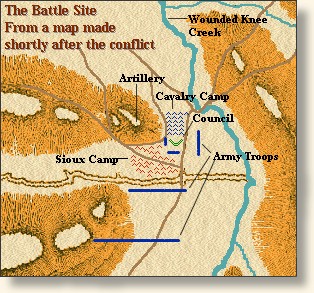
On the morning of December 29, 1890, the Sioux chief Big Foot and some 350 of his followers camped on the banks of Wounded Knee creek. Surrounding their camp was a force of U.S. troops charged with the responsibility of arresting Big Foot and disarming his warriors. The scene was tense. Trouble had been brewing for months.
The hope of
the Ghost Dance |
 the Sioux in South Dakota traveled to Nevada to hear his words. Wovoka called himself the Messiah and prophesied that the dead would soon join the living in a world in which the Indians could live in the old way surrounded by plentiful game. A tidal wave of new soil would cover the earth, bury the whites, and restore the prairie. To hasten the event, the Indians were to dance the Ghost Dance. Many dancers wore brightly colored shirts emblazoned with images of eagles and buffaloes. These "Ghost Shirts" they believed would protect them from the bluecoats' bullets. During the fall of 1890, the Ghost Dance spread through the Sioux villages of the Dakota reservations, revitalizing the Indians and bringing fear to the whites. A desperate Indian Agent at Pine Ridge wired his superiors in Washington, "Indians are dancing in the snow and are wild and crazy....We need protection and we need it now. The leaders should be arrested and confined at some military post until the matter is quieted, and this should be done now." The order went out to arrest Chief Sitting Bull at the Standing Rock Reservation. Sitting Bull was killed in the attempt on December 15. Chief Big Foot was next on the list.
the Sioux in South Dakota traveled to Nevada to hear his words. Wovoka called himself the Messiah and prophesied that the dead would soon join the living in a world in which the Indians could live in the old way surrounded by plentiful game. A tidal wave of new soil would cover the earth, bury the whites, and restore the prairie. To hasten the event, the Indians were to dance the Ghost Dance. Many dancers wore brightly colored shirts emblazoned with images of eagles and buffaloes. These "Ghost Shirts" they believed would protect them from the bluecoats' bullets. During the fall of 1890, the Ghost Dance spread through the Sioux villages of the Dakota reservations, revitalizing the Indians and bringing fear to the whites. A desperate Indian Agent at Pine Ridge wired his superiors in Washington, "Indians are dancing in the snow and are wild and crazy....We need protection and we need it now. The leaders should be arrested and confined at some military post until the matter is quieted, and this should be done now." The order went out to arrest Chief Sitting Bull at the Standing Rock Reservation. Sitting Bull was killed in the attempt on December 15. Chief Big Foot was next on the list. When he heard of Sitting Bull's death, Big Foot led his people south to seek protection at the Pine Ridge Reservation. The army intercepted the band on December 28 and brought them to the edge of the Wounded Knee to camp. The next morning the chief, racked with pneumonia and dying, sat among his warriors and powwowed with the army officers. Suddenly the sound of a shot pierced the early morning gloom. Within seconds the charged atmosphere erupted as Indian braves scurried to retrieve their discarded rifles and troopers fired volley after volley into the Sioux camp. From the heights above, the army's Hotchkiss guns raked the Indian teepees with grapeshot. Clouds of gun smoke filled the air as men, women and children scrambled for their lives. Many ran for a ravine next to the camp only to be cut down in a withering cross fire.
When the smoke cleared and the shooting stopped, approximately 300 Sioux were dead, Big Foot among them. Twenty-five soldiers lost their lives. As the remaining troopers began the grim task of removing the dead, a blizzard swept in from the North. A few days later they returned to complete the job. Scattered fighting continued, but the massacre at Wounded Knee effectively squelched the Ghost Dance movement and ended the Indian Wars.
http://www.eyewitnesstohistory.com/knee.htm
No comments:
Post a Comment